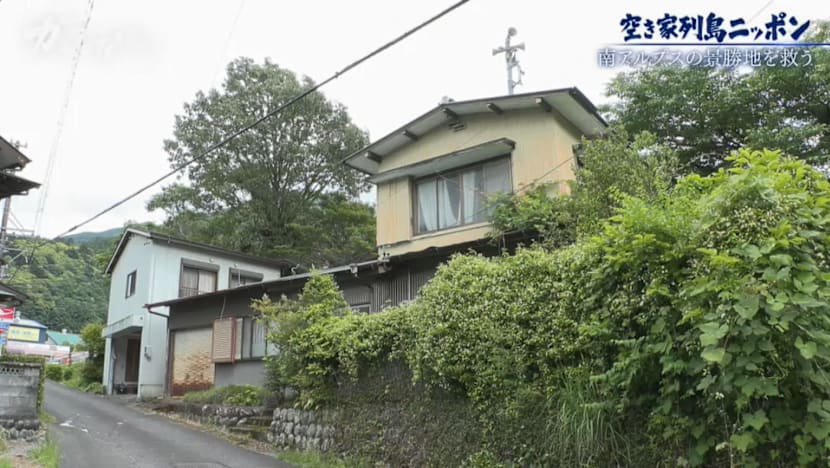Gaia Series 108: Vacant houses archipelago in Japan
With over nine million homes sitting empty, this episode follows local governments, private firms and families trying to reclaim Japan's ageing, abandoned houses before it's too late.


This audio is generated by an AI tool.
As Japan’s vacant house problem grows, officials and families across the country try to find solutions.
In the backstreets of Tokyo’s Setagaya Ward, officials arrive at a house nearly swallowed by vines. The roof has collapsed and a 97-centimetre-wide passage barely leads to the rusted entrance. Steel stairs loom above, corroded and full of holes. On the staircase lies scattered beer cans, though no one knows who left them.
This is one of 13 properties in Setagaya officially designated as dangerous vacant houses. These properties attract pests, pose structural risks and can even become a base for criminal activity. “Do not go in too far. It could collapse,” warns Taeko Chiba, the ward’s chief officer for vacant houses. A foul stench spills out when a window is opened. “It smelled close to mould. That is true of every vacant house,” she says.
Despite a formal demolition order, the owner has not complied. The site’s narrow access prevents heavy machinery from entering, making removal costly. In such cases, the local government steps in to demolish the structure and recovers the cost from the owner. Owners also lose tax benefits and must pay about six times more in property tax.
The problem is far from rare. There are now more than nine million vacant homes across Japan. That is one in seven properties. And Setagaya, despite being Tokyo’s most populous ward with around 510,000 households, has the highest number of vacant homes in the country of about 58,000.
The consequences ripple far beyond aesthetics. Just one vacant house can lower surrounding property values by about three per cent. Unattended, these homes pull down entire communities. “If nobody acts, Japan will be full of empty houses,” the narrator warns.
To counter the trend, Setagaya created a dedicated department for vacant houses and partnered with Vacant House Utilisation Co., chaired by Takamitsu Wada. Together, they launched Setagaya Vacant House Navi, a free consultation service that connects residents with experts.
“The key is to act before a home becomes vacant,” says Wada. “They feel stuck, unable to make decisions. That is why homes end up abandoned.” Emotional ties to these homes often paralyse families.
One such family is that of Mr Ogawa. His mother’s home in Setagaya has stood empty for four years. Built 65 years ago, the two-storey house still makes her proud. “Having my own home was something I always took pride in,” she says. Her late husband, too, loved it deeply. “He felt this was a place he would never leave,” she recalls.
The family eventually decided to demolish the house and sell the land. “You cannot take it with you to the next world,” says the 84-year-old homeowner. “It is best if the two of them divide it gradually and peacefully.”
Another resident, aged 78, travelled from Oita to attend a seminar. His family home in Setagaya has been vacant for 17 years. “My mother truly loved this house. That is why it took so long before it could be dealt with,” he explains. Even the neighbouring house is vacant, with heirs living abroad or far away, making solutions hard to reach.
In rural Kawanehon in Shizuoka, the issue takes a different form. With a population of just over 5,000, one in four houses sits empty. The town created a Vacant House Bank to list properties for sale or renovation. But demand is limited. One two-storey house listed for three years at 2.6 million yen (S$24,000) has seen little interest. Another, built 93 years ago, is priced at 2.3 million yen.
“Large, traditional houses are especially costly to restore,” says property assessor Atsushi Kuroda. “Renovation costs often outweigh the value,” adds his colleague Yuji Ishikawa. Out of 100 properties they assess, only four are purchased.
To help, the town now offers up to two million yen in subsidies. There are also plans to convert some properties into rental homes for new residents. “We cannot clear all the vacant homes ourselves,” says town official Hajime Ogasawara. “But we can create a movement.”
Meanwhile, in Taketa City, Oita, century-old homes stand empty too. Shoji Manabe inherited a historic house built by his grandfather. But it has remained unused for nearly a decade. “Destroying it is painful. I cannot bear it,” he says.
He decided to sell the house to Albalink, a company that specialises in hard-to-sell properties. The sale price was 10 yen. Renovating the home is expected to cost more than 15 million yen. “Maintaining a 110-year-old home carries value beyond money,” Manabe says. “So this 10 yen means a great deal to me.”
The project brings together experts like architect Hiroki Suzuki and social entrepreneur Takamitsu Wada, who plan to turn the house into guest accommodation. “Can it make money, bring excitement and create something new?” Wada asks. That, he says, is the goal.
Back in Tokyo, Ms Chiba continues her rounds. Her department has even produced a home closure guidebook to help residents begin the process. “The essence of the problem is that people simply do not know who to consult,” says Wada.
It is not just about bricks and beams. These homes are symbols of family history, memories and identity. “Selling or tearing down a home full of memories is not easy,” the narrator reflects. But with time, inaction only makes the loss more painful.
For now, Japan remains the land of empty houses. But in pockets across the country, a quiet movement is taking root—one home at a time.












